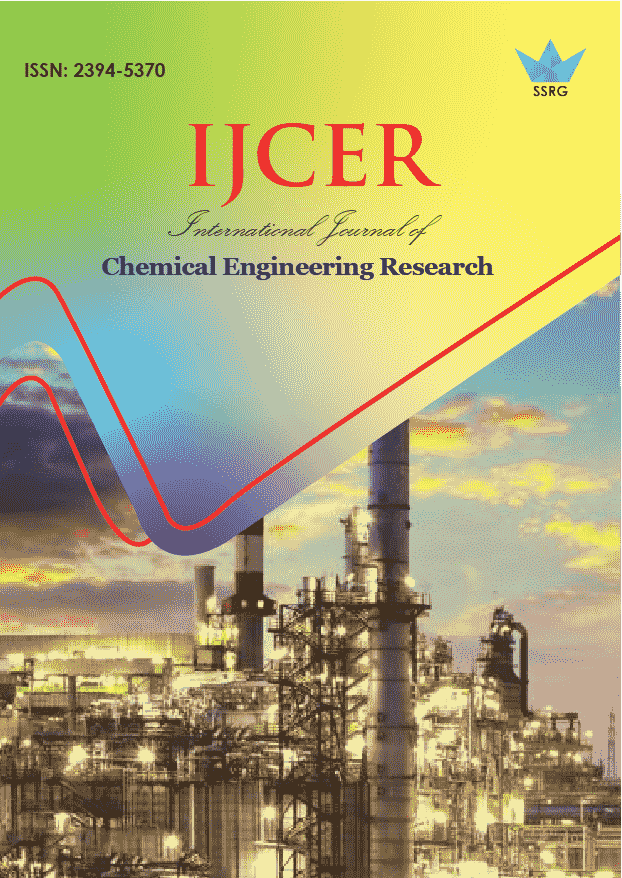Toxicity Measurement of Sediments with Accepted Anomalous Deliberation in Heavy Metals by the Exploit of Bioassay

| International Journal of Chemical Engineering Research |
| © 2015 by SSRG - IJCER Journal |
| Volume 2 Issue 3 |
| Year of Publication : 2015 |
| Authors : Dr.R.Sumathi, B.Sudha |
How to Cite?
Dr.R.Sumathi, B.Sudha, "Toxicity Measurement of Sediments with Accepted Anomalous Deliberation in Heavy Metals by the Exploit of Bioassay," SSRG International Journal of Chemical Engineering Research, vol. 2, no. 3, pp. 1-4, 2015. Crossref, https://doi.org/10.14445/23945370/IJCER-V2I2P101
Abstract:
The potential toxicity in riverbed sediments was assessed with a bioassay by means of the bioluminescent bacteria Vibrio fischeri. The elected area was characterized by the attendance of ultramafic rocks (peridotites), and the sediments had elevated values in Ni, Cr, and Co. For the toxicity bioassay with Vibrio fischeri, water-soluble forms were worn. The results indicated that mainly of the samples had a very low quantity of toxicity, with 14% of decrease in luminescence in relative to the organize; meanwhile 29% of the samples had a reasonable degree of toxicity with a decrease in luminescence among 15 and 23% in relation to the manage. The toxicity index interrelated considerably with the concentrations of Ni and Cr in the water extracts. This toxicity bioassay was proved to be a responsive and functional tool to detect potential toxicity in solutions, even with inconsistent concentrations in heavy metals of ordinary origin. . Ecological risk assessments can be worn to anticipate the likelihood of future belongings or approximation the likelihood that effects are caused by past opening to stressors.
Keywords:
Toxicity Bioassay, Vibrio fischeri, Verde River, Luminescence, ANOVA.
References:
[1] Francisco Mart´ın, Marlon Escoto, Juan Fern´andez, Emilia Fern´andez, Elena Arco, Manuel Sierra, and Carlos Dorronsoro, Toxicity Assessment of Sediments with Natural Anomalous Concentrations in Heavy Metals by the Use of Bioassay, Hindawi Publishing Corporation International Journal of Chemical Engineering, Volume 2010, Article ID 101390, 6 pages, 2010.
[2] M. Rutgers, J. Faber, and J. Postma, “Site-specific ecological risks—a basic approach to function-specific assessment of soil pollution,” Tech. Rep. 16, Netherlands Integrated Soil Research Programme Reports, Wageningen, The Netherlands, 2001, English version no. 28.
[3] D. J. L. Thomas, S. F. Tyrrel, R. Smith, and S. Farrow, “Bioassays for the evaluation of landfill leachate toxicity,” Journal of Toxicology and Environmental Health B, vol. 12, no. 1, pp. 83–105, 2009.
[4] S. Girotti, E. N. Ferri, M. G. Fumo, and E. Maiolini, “Monitoring of environmental pollutants by bioluminescent bacteria,” Analytical Chemica Acta, vol. 608, no. 1, pp. 2–29, 2008.
[5] S. Parvez, C. Venkataraman, and S. Mukherji, “A review on advantages of implementing luminescence inhibition test (Vibrio fischeri) for acute toxicity prediction of chemicals,” Environment International, vol. 32, no. 2, pp. 265–268, 2006.
[6] F. Mart´ın, M. Diez, M. Sim´ on, C. Dorronsoro, and I. Garc´ıa, “Soil contamination: from large to small scale,” in Soil Contamination: New Research, pp. 35–45, Nova Science, Hauppauge, NY, USA, 2008.
[7] U. Kraus and J.Wiegand, “Long-term effects of the Aznalc ´ ollar mine spill-heavy metal content and mobility in soils and sediments of the Guadiamar river valley (SW Spain),” Science of the Total Environment, vol. 367, no. 2-3, pp. 855–871, 2006.
[8] A. V. Filgueiras, I. Lavilla, and C. Bendicho, “Evaluation of distribution, mobility and binding behaviour of heavy metals in surficial sediments of Louro River (Galicia, Spain) using chemometric analysis: a case study,” Science of the Total Environment, vol. 330, no. 1–3, pp. 115–129, 2004.
[9] S. Olivares-Rieumont, D. De La Rosa, L. Lima et al., “Assessment of heavy metal levels in Almendares River sediments— Havana City, Cuba,” Water Research, vol. 39, no. 16, pp. 3945– 3953, 2005.

 10.14445/23945370/IJCER-V2I2P101
10.14445/23945370/IJCER-V2I2P101